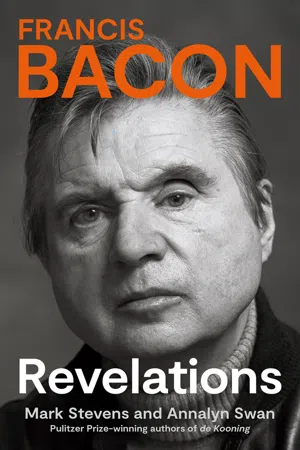
- English
- ePUB (mobile friendly)
- Available on iOS & Android
FRANCIS BACON EB
About this book
The Times Art Book of the Year 2021
FINALIST FOR THE PLUTARCH AWARD 2022
'Must surely be the definitive life of Francis Bacon … A biography that no Bacon fan – or indeed foe – can afford to overlook … Mesmerising' THE TIMES
'A magnificent triumph … I was captivated by every line' OBSERVER
A decade in the making, based upon hundreds of interviews and extensive new material, Pulitzer Prize winners Mark Stevens and Annalyn Swan have written a startlingly original portrait – rich, complex, and subtle – of a commanding modern figure.
Bacon concealed many important aspects of his life. He described himself as an asthmatic child in Ireland with foxhunting parents and a tyrannical father, but he was also rescued by a series of formidable women – women who in this biography emerge in their own right. He was never just a dissolute young man but was also a passionate reader, largely self-taught. Early on, influenced by Eileen Gray, he became a hard-working and ambitious designer, a brief career explored here in detail for the first time. He dreamed of remaking the modern room.
Bacon worked no less hard or ambitiously as a painter, at first with little success. Throughout the 1930s and early '40s he suffered ongoing failures, growing isolated and often ill. His health issues throughout his life were far more significant than he revealed. Then came his astonishing breakthrough in 1944, with Three Studies for Figures at the Base of a Crucifixion. In the following decades, he emerged as one of the great iconoclasts and bon vivants of his time, a Wildean figure whom one friend called 'a terrific grandee.' Bacon was typically celebrated as a sexual adventurer who liked rough trade, but he never stopped longing for a serious committed relationship, however painful. He continued to make disturbing images of the strangeness within, but developed into a more varied artist than has been recognised, creating in particular an extraordinary series of self-portraits. He was an artist who believed in chance and paradox: the iconoclast eventually became an icon.
This is a story, deeply researched and masterfully told, of a sickly boy who became one of the great figures of his time. The twentieth century does not know itself without Bacon.
Frequently asked questions
- Essential is ideal for learners and professionals who enjoy exploring a wide range of subjects. Access the Essential Library with 800,000+ trusted titles and best-sellers across business, personal growth, and the humanities. Includes unlimited reading time and Standard Read Aloud voice.
- Complete: Perfect for advanced learners and researchers needing full, unrestricted access. Unlock 1.4M+ books across hundreds of subjects, including academic and specialized titles. The Complete Plan also includes advanced features like Premium Read Aloud and Research Assistant.
Please note we cannot support devices running on iOS 13 and Android 7 or earlier. Learn more about using the app.
Information
Notes
Table of contents
- Cover
- Title Page
- Copyright
- Dedication
- Contents
- Prologue: The Dark Century
- “I”
- Iconoclast
- “Icon”
- Picture Section
- Notes
- Documentation
- Index
- Acknowledgements
- Illustration Credits
- About the Author
- Also by Mark Stevens and Annalyn Swan
- About the Publisher